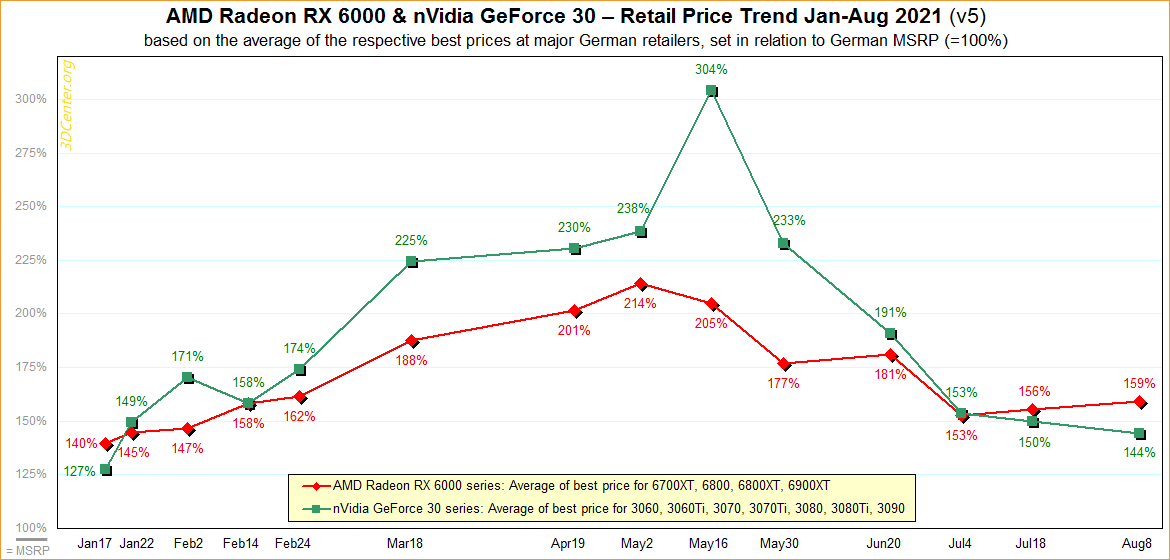GPU Market Update: High Prices And What To Expect

Table of Contents
Current State of the GPU Market: A Pricey Landscape
The current GPU market is characterized by persistently high prices, making it a challenging environment for consumers. The impact is felt across the board, from budget-conscious gamers struggling to find affordable graphics cards to high-end enthusiasts facing inflated costs for top-of-the-line models. This challenging situation stems from a confluence of factors:
-
Persistent chip shortages affecting GPU production: The global semiconductor shortage continues to constrain the production of GPUs, limiting the supply available to meet the high demand. This directly impacts the availability of both entry-level and high-end cards. Manufacturers are struggling to keep up with orders, leading to extended lead times.
-
Increased demand fueled by gaming, cryptocurrency mining, and AI applications: The surging popularity of gaming, coupled with the continued demand for GPUs in cryptocurrency mining and increasingly sophisticated AI applications, has created an intense battle for limited resources. The high demand pushes prices upwards, making it difficult for consumers to find GPUs at MSRP (Manufacturer's Suggested Retail Price).
-
Scalpers and bots exacerbating price inflation: The limited availability of GPUs has created a breeding ground for scalpers who use bots to snatch up cards in bulk and resell them at significantly inflated prices on online marketplaces. This further restricts access for legitimate buyers and inflates the perceived market value.
-
Limited availability leading to long wait times for desired models: Many popular GPU models remain perpetually out of stock at major retailers. Consumers often face significant delays, sometimes stretching for months, before they can acquire the desired graphics card. This scarcity fuels the high prices and intensifies competition amongst buyers.
-
High MSRP (Manufacturer's Suggested Retail Price) from manufacturers: Even when GPUs are available, the MSRP itself has increased compared to previous generations, reflecting the increased cost of production and raw materials. This sets a higher baseline price before any additional retailer markups or scalper activity takes place.
The impact on different market segments is significant. Budget gamers are particularly hard hit, often forced to compromise on performance or wait indefinitely for more affordable options. High-end enthusiasts, while potentially better positioned financially, still face inflated costs and long wait times for the latest and most powerful GPUs. For example, cards like the NVIDIA RTX 4090 and AMD Radeon RX 7900 XTX, while powerful, are significantly more expensive than their predecessors.
Factors Contributing to High GPU Prices
The high prices in the GPU market are not a result of a single cause but rather a complex interplay of several interconnected factors:
-
Global supply chain disruptions: The global pandemic exposed and exacerbated vulnerabilities in the intricate supply chains necessary for GPU manufacturing. Disruptions in logistics, transportation, and component availability have significantly impacted production timelines and increased costs.
-
Increased costs of raw materials and manufacturing: The price of raw materials crucial for GPU production, such as silicon wafers and other semiconductors, has risen sharply. Additionally, the cost of manufacturing, including energy and labor, has also increased, adding to the overall price.
-
High energy costs impacting production facilities: The rising cost of energy, a major factor in the manufacturing process, further adds to the overall production cost of GPUs. This energy price increase is a global phenomenon impacting various industries, including semiconductor manufacturing.
-
Geopolitical instability and trade wars: Geopolitical tensions and trade disputes between countries have added another layer of complexity to the global supply chain, disrupting the flow of materials and components needed for GPU production. This uncertainty increases risk and costs for manufacturers.
-
The ongoing impact of the COVID-19 pandemic on global manufacturing: The pandemic's lingering effects on global manufacturing capacity continue to impact GPU production. Labor shortages, factory closures, and disruptions to logistics all contribute to the scarcity and high prices of GPUs.
The interconnectedness of these factors cannot be overstated. Each issue compounds the others, creating a perfect storm that drives up GPU prices and makes them difficult to acquire. For example, supply chain disruptions lead to increased raw material costs, which then impact manufacturing costs, leading to higher MSRPs.
Predictions for the Future of the GPU Market
While the current situation is challenging, there are reasons to believe that the GPU market may eventually stabilize. Several factors could contribute to this shift:
-
Potential easing of supply chain issues in the near future: While still fragile, global supply chains are slowly showing signs of recovery. Improvements in logistics, increased production capacity in some areas, and diversification of supply sources may gradually alleviate the shortages.
-
Expected increase in GPU production capacity: Manufacturers are investing heavily in expanding their production capacity to meet the ongoing demand. This increase in production should, over time, lead to greater availability of GPUs and potentially lower prices.
-
Anticipated impact of new GPU generations and technologies: The introduction of new GPU generations with improved manufacturing processes and potentially more efficient designs could increase production yields and reduce costs per unit. This is a long-term trend that holds promise for the future.
-
The potential role of alternative mining technologies in reducing demand: The rise of alternative, less GPU-intensive cryptocurrency mining techniques could potentially reduce the demand for GPUs from this sector, freeing up more supply for gamers and other consumers. However, the impact of this is still uncertain.
-
Predictions for price drops (realistic timeframe and percentage): While pinpointing exact dates and percentages is difficult, industry analysts predict a gradual easing of prices over the next 12-18 months. A 10-20% price reduction in some models within this timeframe is a plausible expectation, although this will likely vary depending on the specific GPU model and market conditions.
Experts believe that technological advancements, such as advancements in chip manufacturing processes (e.g., EUV lithography), will play a significant role in reducing production costs and making GPUs more accessible.
When is a Good Time to Buy a GPU?
Navigating the current GPU market requires patience and strategy. Here are some tips:
-
Monitor price trends and sales: Regularly check major retailers and online marketplaces for price drops and sales. Price-tracking websites can help identify the best deals.
-
Consider used or refurbished GPUs (with caution): Used or refurbished GPUs can offer a more affordable entry point, but proceed with caution. Thoroughly research the seller and ensure the card is in good working condition with a warranty.
-
Prioritize needs vs. wants when choosing a GPU: Determine your gaming needs and budget. Don't feel pressured to buy the most powerful GPU if your system and games don't require it.
-
Be patient and wait for price reductions: If possible, delay your purchase until prices stabilize and more supply becomes available. This is likely the best approach for many buyers.
-
Explore alternative solutions like cloud gaming: Cloud gaming services offer a viable alternative for gamers who don't want to invest in expensive hardware, providing access to high-quality gaming experiences without owning a powerful GPU.
Remember to compare prices across multiple sources before making a purchase and be wary of suspiciously low prices, which may be a sign of a scam.
Conclusion
The high GPU prices we're currently experiencing are a result of a complex interplay of factors, including persistent chip shortages, high demand from various sectors, supply chain disruptions, and increased production costs. While the situation remains challenging, predictions suggest a gradual easing of prices over the next year or two as production capacity increases and supply chains stabilize. To navigate this market effectively, stay informed about the fluctuating GPU market and monitor price trends closely. Regularly check for updates and price comparisons to secure the best deal when purchasing your next GPU. Keep an eye on this blog for future GPU market updates and advice on navigating the ever-changing world of GPU prices.

Featured Posts
-
 Denny Hamlins Martinsville Win Breaking The Drought
Apr 28, 2025
Denny Hamlins Martinsville Win Breaking The Drought
Apr 28, 2025 -
 Boston Red Sox Doubleheader Coras Lineup Changes For Game 1
Apr 28, 2025
Boston Red Sox Doubleheader Coras Lineup Changes For Game 1
Apr 28, 2025 -
 Richard Jefferson Espn Interview Le Bron James Reaction
Apr 28, 2025
Richard Jefferson Espn Interview Le Bron James Reaction
Apr 28, 2025 -
 Investigation Into Lingering Toxic Chemicals In Buildings Following Ohio Train Derailment
Apr 28, 2025
Investigation Into Lingering Toxic Chemicals In Buildings Following Ohio Train Derailment
Apr 28, 2025 -
 Mike Breen On Marv Albert A Discussion On The Greatest Basketball Announcer
Apr 28, 2025
Mike Breen On Marv Albert A Discussion On The Greatest Basketball Announcer
Apr 28, 2025
Latest Posts
-
 Phoenix Nascar Race Bubba Wallaces Crash Attributed To Brake Failure
Apr 28, 2025
Phoenix Nascar Race Bubba Wallaces Crash Attributed To Brake Failure
Apr 28, 2025 -
 Brake Issue Leads To Bubba Wallace Crash At Nascar Phoenix Race
Apr 28, 2025
Brake Issue Leads To Bubba Wallace Crash At Nascar Phoenix Race
Apr 28, 2025 -
 Bubba Wallace Involved In High Speed Crash At Phoenix Raceway Due To Brake Problems
Apr 28, 2025
Bubba Wallace Involved In High Speed Crash At Phoenix Raceway Due To Brake Problems
Apr 28, 2025 -
 Nascar Phoenix Bubba Wallace Suffers Brake Failure Crashes
Apr 28, 2025
Nascar Phoenix Bubba Wallace Suffers Brake Failure Crashes
Apr 28, 2025 -
 Bubba Wallaces Phoenix Crash Brake Failure Causes Wall Impact
Apr 28, 2025
Bubba Wallaces Phoenix Crash Brake Failure Causes Wall Impact
Apr 28, 2025
